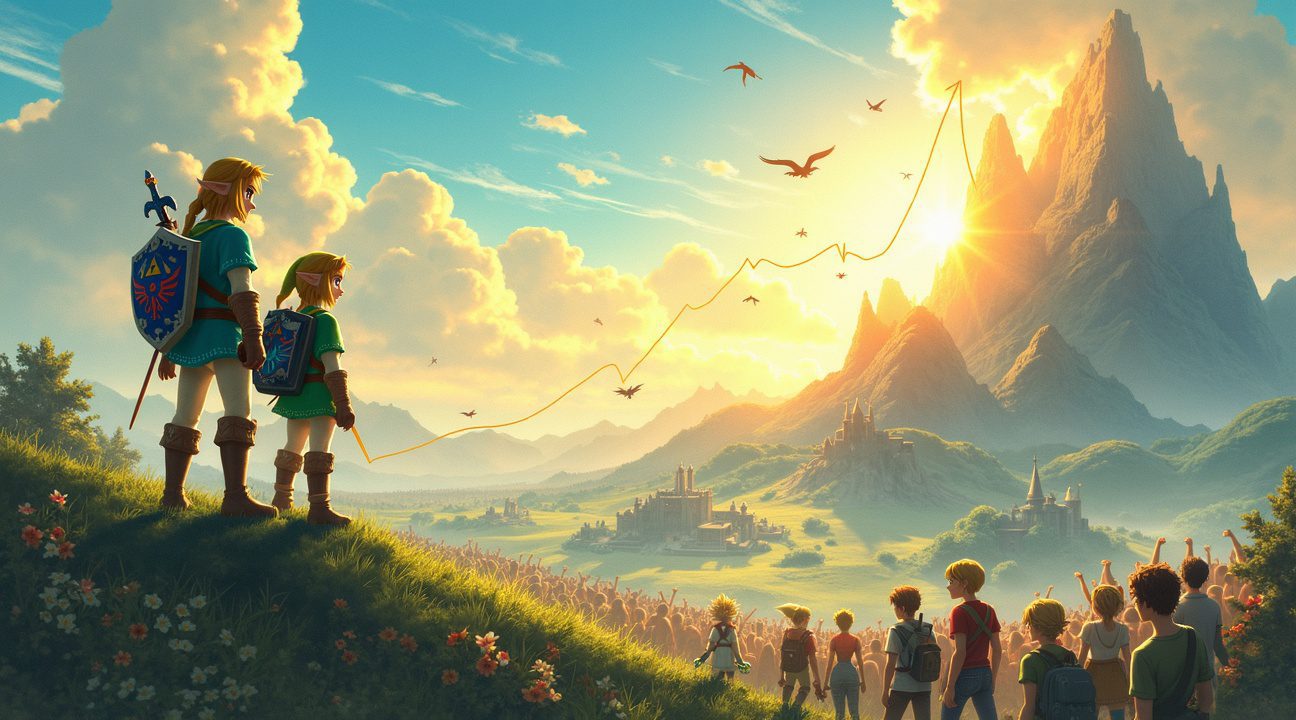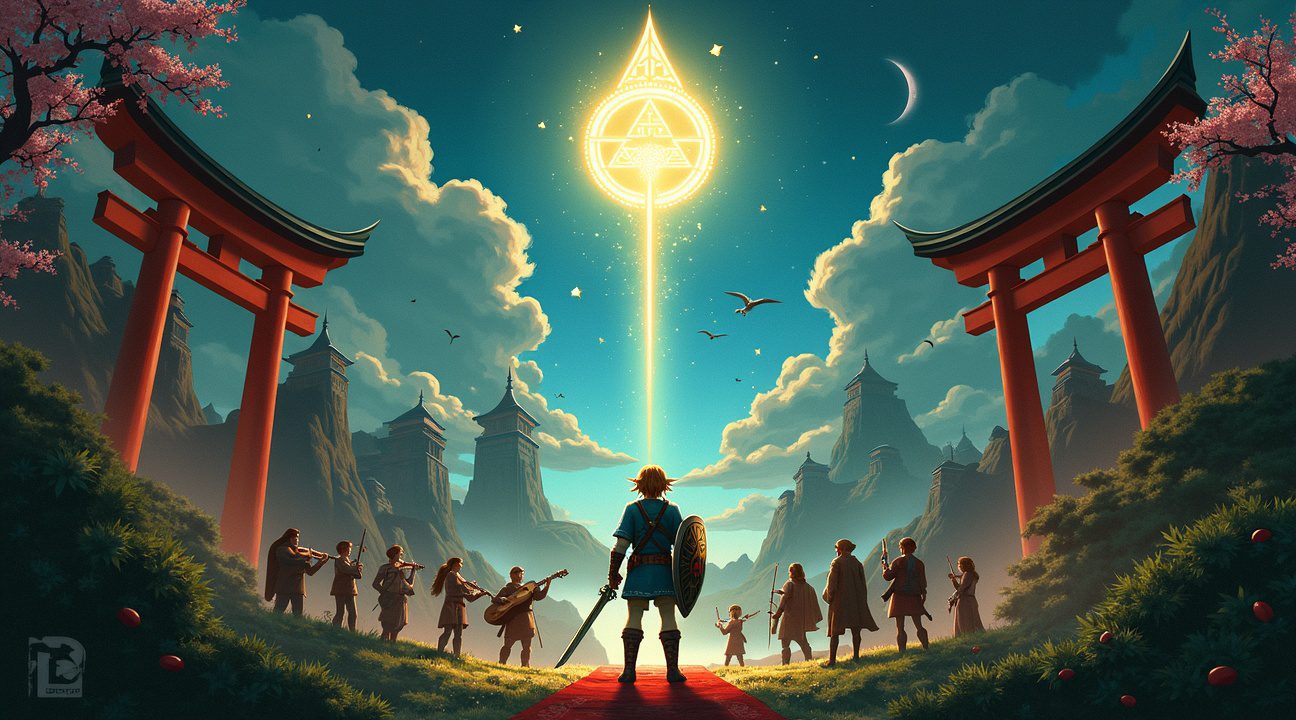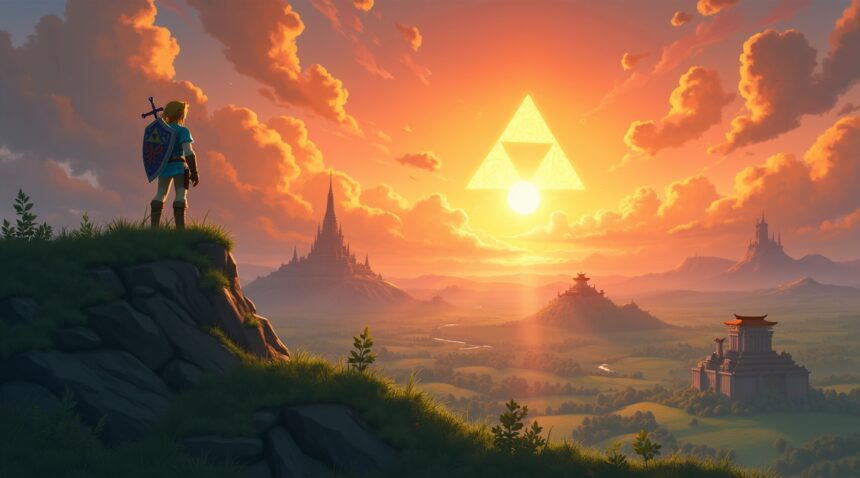The Legend of Zelda franchise has achieved remarkable commercial success with over 150 million units sold worldwide, establishing itself as one of gaming’s most influential properties that consistently pushes industry boundaries.
Key Takeaways
- The franchise has sold over 150 million units globally, with Breath of the Wild leading at 34.32 million copies and Tears of the Kingdom achieving 21.55 million sales.
- Zelda operates as a premium franchise within Nintendo’s portfolio, prioritizing innovation and cultural impact over the volume sales achieved by franchises like Mario Kart or Animal Crossing.
- Breath of the Wild revolutionized open-world game design and influenced an entire generation of developers across the industry.
- The series has evolved from a Japanese cultural export into a global gaming icon that bridges Eastern and Western storytelling traditions.
- Each major Zelda release serves as a cultural event generating widespread media coverage and community engagement, ensuring decades of relevance in gaming.
Strategic Positioning and Innovation
Nintendo has positioned the series strategically as a premium offering that commands significant media attention with each release. Rather than chasing volume sales, the franchise focuses on delivering consistent quality and innovation. Breath of the Wild shifted industry perspectives on exploration mechanics and player agency. Developers now frequently reference its physics-based interactions and chemistry systems as benchmarks in open-world game development.
Development Philosophy
The financial success of the series reflects careful development cycles that emphasize thorough polish over rushing titles to market. Each major entry benefits from substantial marketing support and critical acclaim. Sales data demonstrates strong consumer confidence in the brand. The rapid commercial success of Tears of the Kingdom validated the approach of investing deeply in expanding and innovating upon an already strong foundation.
Cultural Impact
The Legend of Zelda’s cultural influence extends beyond traditional gaming circles and permeates mainstream entertainment discussions. The franchise’s unique art direction and approach to narrative attract a broad demographic. The seamless blend of Eastern design philosophies with Western style gameplay has created a lasting, cross-cultural appeal that contributes to sustained, global commercial performance.
Zelda Breaks Records: Over 150 Million Units Sold Worldwide Makes It Nintendo’s Gaming Powerhouse
I’ve watched The Legend of Zelda franchise evolve from a modest adventure game into one of gaming’s most dominant forces, and the numbers tell an incredible story. Nintendo’s beloved franchise has achieved a monumental milestone, selling over 150 million units worldwide as of March 2025, cementing its status as one of the most successful gaming properties in history.
The franchise’s commercial explosion reached unprecedented heights with The Legend of Zelda: Breath of the Wild, which revolutionized open-world gaming and captured 34.32 million players worldwide. This remarkable achievement makes Breath of the Wild not just the best-selling Zelda title, but also showcases how Breath of the Wild’s importance extends far beyond traditional franchise boundaries.
Modern Zelda Dominates Sales Charts
Tears of the Kingdom continued this momentum with explosive launch numbers that shattered industry expectations. The 2023 release garnered 21.55 million unit sales, demonstrating that Nintendo’s formula for innovation remains as potent as ever. What impressed me most was the game’s opening performance – 10 million copies sold within just three days of release, proving that modern Zelda games have transcended niche appeal to become mainstream gaming events.
These recent successes highlight how the franchise has adapted to contemporary gaming preferences while maintaining its core identity. Both Breath of the Wild and Tears of the Kingdom attracted players who had never touched a Zelda game before, expanding the audience far beyond longtime fans. The sales figures reflect this broader appeal, with each title becoming genuine triumphs in their own right.
Classic Titles Maintain Strong Performance
The franchise’s enduring appeal becomes evident when examining classic title performance across multiple generations:
- The Legend of Zelda: Ocarina of Time achieved 14.04 million units sold, establishing benchmarks for 3D adventure games that influence developers today.
- Link’s Awakening reached 12.68 million units, proving that both classic gameplay and modern remakes can find substantial audiences decades after original release.
- Twilight Princess rounds out the top earners with 10.02 million units sold, demonstrating consistent franchise strength across different console generations.
These numbers reflect more than commercial success – they represent sustained cultural relevance across gaming communities worldwide. Each major release builds upon previous entries while introducing fresh mechanics that keep the franchise feeling current and innovative.
The sales data reveals how Zelda has become Nintendo’s most reliable franchise beyond Mario, consistently delivering both critical acclaim and commercial returns. Industry analysts often point to Zelda as proof that single-player, story-driven games remain viable in an increasingly multiplayer-focused market. The franchise’s ability to generate high critical scores while achieving massive sales numbers showcases exceptional development quality.
Modern gaming communities treat new Zelda releases as cultural events rather than simple product launches. Social media explodes with theories, discoveries, and shared experiences whenever Nintendo announces upcoming Zelda content. This level of engagement translates directly into sales momentum, creating cycles where anticipation builds lasting commercial success.
The 150 million unit milestone positions Zelda among gaming’s elite franchises, comparable to properties like Grand Theft Auto and Call of Duty in terms of global reach. However, Zelda maintains this success while preserving artistic integrity and gameplay innovation, avoiding the iterative approaches common in other blockbuster series. Each major release feels essential rather than formulaic, contributing to sustained sales performance across decades.

How Breath of the Wild Revolutionized Gaming and Influenced an Entire Industry
The Legend of Zelda: Breath of the Wild fundamentally transformed how developers and players think about open-world game design. I’ve witnessed firsthand how this 2017 masterpiece broke away from traditional Zelda conventions, replacing linear progression with complete freedom of exploration. Players could tackle the game’s challenges in any order they chose, creating unique experiences that felt personal and unrestricted.
Setting New Industry Standards Through Innovation
Nintendo’s decision to embrace sandbox freedom created a template that countless developers have since adopted. The game’s experimental mechanics, from its dynamic weather system to physics-based puzzle solving, established new benchmarks for interactive world design. Major studios took notice, with titles like Elden Ring incorporating similar philosophies of discovery-driven exploration and player agency.
The indie gaming scene particularly embraced these design principles, with smaller developers finding inspiration in Breath of the Wild’s approach to environmental storytelling and emergent gameplay. I’ve observed how the game’s influence extends beyond just open-world mechanics, affecting everything from user interface design to narrative pacing across multiple genres.
- Innovative sandbox freedom
- Dynamic environmental systems
- Physics-driven puzzles
- Nonlinear progression
Critical Acclaim and Industry Recognition
The critical response was nothing short of extraordinary, with publications worldwide recognizing the game’s revolutionary impact. Famitsu awarded it a perfect 40/40 score, while Metacritic ratings reached an impressive 97/100. These weren’t just numbers—they reflected genuine industry consensus about the game’s significance.
IGN’s recognition of Breath of the Wild as the ‘best game of the decade’ cemented its status as a cultural phenomenon. The accolades continued with multiple Game of the Year awards and recognition from development communities worldwide. Critics consistently praised its seamless integration of exploration mechanics with environmental puzzle design.
- Famitsu: 40/40
- Metacritic: 97/100
- IGN: Best Game of the Decade
- Game of the Year awards across numerous platforms
The game’s commercial success matched its critical reception, with sales figures that demonstrated players’ appetite for this new approach to game design. Its influence can be traced through subsequent releases that adopted similar design philosophies, proving that Breath of the Wild didn’t just succeed—it redefined what players expect from modern gaming experiences.
This revolutionary title established design trends that continue shaping today’s gaming landscape, proving that innovation and player freedom remain powerful forces in game development.
Zelda’s Rise to Cultural Icon: From Japanese Export to Global Gaming Phenomenon
The Legend of Zelda stands as one of Japan’s most influential cultural exports, transforming from a modest 8-bit adventure into a cornerstone of global gaming culture. Nintendo’s flagship series has achieved something remarkable: it’s become a bridge between Eastern and Western storytelling traditions while maintaining its distinctly Japanese identity.
I’ve witnessed how this series operates as a form of soft power, spreading Japanese cultural values and aesthetics across international boundaries. The games blend Japanese folklore with European fairy tale elements, creating mythology that resonates with players from diverse backgrounds. Link’s silent heroism reflects Japanese concepts of duty and perseverance, while the fantasy settings draw from Western medieval traditions that feel familiar to global audiences.
A Thriving Global Community
The Zelda community demonstrates unprecedented engagement across multiple platforms and creative outlets. Fans actively participate in various forms of cultural expression that extend far beyond simply playing the games:
- Speedrunning communities have transformed Zelda titles into competitive events, with runners discovering new techniques and routes that captivate audiences worldwide
- Fan artists create thousands of illustrations, animations, and sculptures inspired by characters and environments from the series
- Musicians compose elaborate orchestral arrangements and remix iconic soundtracks, with some performances attracting millions of viewers
- Theorists dissect timeline connections and hidden lore, generating discussions that span decades and maintain engagement between releases
- Cosplayers bring characters to life at conventions globally, making Zelda one of the most represented franchises in costume communities
Each new release triggers immediate viral phenomena that demonstrate the series’ cultural reach. Upcoming Legend of Zelda game announcements regularly break internet engagement records, with trailer reveals generating millions of views within hours. The anticipation surrounding Tears of the Kingdom exemplified this phenomenon, creating a cultural event that transcended gaming circles and entered mainstream media coverage.
The series has achieved something many Japanese cultural products struggle with: it maintains authentic Japanese sensibilities while feeling universal. Link’s character embodies Japanese heroic ideals without alienating Western audiences who might not understand these cultural nuances. The games present concepts like harmony with nature, respect for tradition, and the importance of community bonds in ways that feel organic rather than preachy.
I’ve observed how gaming experiences within the Zelda series continue setting industry standards that other developers attempt to emulate. The influence extends beyond mechanics into artistic direction, sound design, and narrative structure. Many modern adventure games clearly draw inspiration from Zelda’s formula, yet none have replicated its unique cultural impact.
The franchise’s status as a cultural icon isn’t just about entertainment value. Academic institutions study Zelda games in courses covering game design, Japanese culture, and digital storytelling. Museums have featured exhibitions dedicated to the series’ artistic evolution. Symphony orchestras perform Zelda concerts in prestigious venues worldwide, elevating video game music to classical art status.
This cultural penetration has created a phenomenon where Zelda references appear in contexts completely removed from gaming. Fashion designers incorporate Triforce symbols into high-end collections. Artists reference Zelda imagery in gallery exhibitions. Musicians across genres sample or reference Zelda melodies in their compositions.
The series demonstrates how Japanese cultural exports can achieve global dominance without losing their essential character. Zelda’s latest adventure continues this tradition, proving that authentic cultural expression often resonates more powerfully than products designed specifically for international markets. The franchise has become a cultural ambassador, introducing millions of players to Japanese aesthetic principles, storytelling approaches, and philosophical concepts through the medium of interactive entertainment.

Decades of Innovation: How Zelda Continuously Reinvents the Action-Adventure Genre
The Legend of Zelda series stands as a testament to sustained innovation within the action-adventure genre, consistently introducing groundbreaking features that become industry standards. I’ve witnessed firsthand how this franchise transforms gaming conventions into evolutionary leaps that influence countless other titles.
Revolutionary Foundations and Technological Breakthroughs
Nintendo established the series’ innovative legacy with the original Legend of Zelda in 1986, which achieved remarkable sales of 7.54 million units while introducing concepts that seemed revolutionary at the time. Battery-powered saving eliminated the need for complex password systems, allowing players to maintain progress across multiple gaming sessions. This technical advancement fundamentally changed how developers approached game design and player engagement.
Open-ended exploration became another defining characteristic that set Zelda apart from linear action games of the era. Players could tackle dungeons in various orders, discover secrets through experimentation, and develop personal strategies for progression. The intuitive interface design made complex actions feel natural, creating accessibility without sacrificing depth. These elements combined to establish benchmarks in narrative delivery and interactive storytelling that competitors struggled to match.
Modern Evolution and Continued Market Success
Recent entries demonstrate how the franchise maintains relevance while pushing genre boundaries. Skyward Sword achieved 7.82 million units in sales by incorporating motion controls that transformed sword combat into physical gestures, though this innovation proved polarizing among fans. The latest Zelda games continue experimenting with new mechanics while respecting core principles that define the series.
The Legend of Zelda: Echoes of Wisdom represents another bold step forward, selling over 2.58 million units shortly after release. This success indicates that fans remain eager to embrace fresh gameplay concepts when they’re executed thoughtfully. The game’s unique echo mechanics allow players to replicate and manipulate objects in creative ways, adding puzzle-solving dimensions that feel both familiar and innovative.
Sales figures across different entries reveal how gameplay innovation directly correlates with market performance and critical reception. Each major release typically introduces at least one significant mechanical advancement alongside refinements to existing systems, including:
- Motion controls
- Dual-screen gameplay
- Time manipulation
- Physics-based interactions
These innovations often influence other developers who incorporate similar mechanics into their own titles, creating ripple effects throughout the gaming industry. Open-world mechanics that appeared primitive in early Zelda games now serve as foundational elements for modern action-adventure titles. The series’ approach to environmental storytelling, where players discover narrative details through exploration rather than exposition, has become standard practice across multiple genres.
Contemporary gaming communities recognize Zelda’s contributions to interactive entertainment design, frequently citing specific innovations when discussing genre evolution. Forums and social media platforms regularly feature discussions about how particular Zelda mechanics influenced other beloved games. The Tears of the Kingdom triumph exemplifies how modern entries continue pushing boundaries while maintaining the series’ innovative spirit.
Gaming milestones achieved by Zelda titles often center around their willingness to challenge player expectations and genre conventions. Each entry asks players to reconsider what action-adventure games can accomplish, whether through technological integration, narrative structure, or mechanical complexity. This consistent push for advancement ensures the franchise remains relevant decades after its debut, attracting new players while satisfying longtime fans who expect continued evolution from each release.
Standing Among Giants: How Zelda Compares to Nintendo’s Biggest Franchises
I find it fascinating how Zelda maintains its prestigious position within Nintendo’s ecosystem, even when its sales figures don’t match the astronomical numbers achieved by the company’s most commercially successful titles. While Zelda Tears of the Kingdom represents a pinnacle of achievement for the franchise, it operates in a different market segment compared to Nintendo’s sales juggernauts.
Mario Kart 8 Deluxe currently dominates Nintendo’s sales charts with 68.20 million units sold, establishing itself as the platform’s absolute champion. Animal Crossing: New Horizons follows closely behind at 47.82 million units, while Super Smash Bros. Ultimate rounds out the top three with 36.24 million copies sold. These numbers reflect the broad appeal and accessibility that characterizes Nintendo’s most commercially successful franchises.
Legacy Status Creates Different Success Metrics
The Zelda franchise operates under different parameters than these high-volume sellers, and I believe this distinction actually strengthens its position rather than diminishes it. Where Mario Kart appeals to casual and competitive players alike with its straightforward racing mechanics, and Animal Crossing attracts millions through its relaxing social simulation gameplay, Zelda targets players seeking deeper narrative experiences and complex puzzle-solving challenges.
This positioning creates several advantages that raw sales figures don’t capture:
- Cultural impact that extends far beyond gaming communities
- Critical acclaim that consistently elevates Nintendo’s brand prestige
- Long-term player engagement that spans decades rather than seasonal bursts
- Innovation leadership that influences industry-wide design trends
- Premium pricing power that maintains higher profit margins per unit
I’ve observed how Zelda’s gaming experience creates a different type of customer relationship compared to Nintendo’s volume leaders. Players don’t just purchase Zelda games; they invest emotionally in Link’s adventures and become part of a dedicated community that spans generations. This emotional connection translates into sustained franchise value that transcends individual title performance.
Nintendo recognizes this dynamic, which explains why the company continues investing heavily in Zelda development despite lower unit sales. Each mainline Zelda release serves as a showcase for Nintendo’s creative capabilities and technical prowess. Breath of the Wild’s importance in reshaping open-world game design exemplifies how Zelda’s influence extends far beyond its immediate sales impact.
The gaming community’s perception of Zelda also differs significantly from how they view Mario Kart or Animal Crossing. While those franchises excel at providing accessible entertainment, Zelda represents artistry and innovation within interactive entertainment. This reputation allows Nintendo to command premium prices and generate significant media coverage that benefits the entire Nintendo ecosystem.
Furthermore, I notice how Zelda’s release schedule contributes to its sustained relevance. Unlike annual sports franchises or frequent mobile updates, major Zelda releases arrive as cultural events. Tears of the Kingdom’s Metascore excellence demonstrates how this approach maintains quality standards that keep the franchise competitive against newer properties.
The franchise comparison reveals how Nintendo successfully operates multiple franchise tiers with distinct purposes:
- Mario Kart drives hardware sales through mass market appeal
- Animal Crossing creates social engagement platforms
- Zelda establishes creative credibility while maintaining devoted fan loyalty
Each serves specific strategic functions within Nintendo’s broader portfolio management approach.
This diversified strategy allows Nintendo to weather market changes more effectively than companies dependent on single franchise types. When casual gaming trends shift, Zelda’s core audience remains stable. When hardcore gaming preferences evolve, Zelda adapts while maintaining its fundamental identity. This flexibility explains why Zelda continues thriving despite operating in Nintendo’s most competitive internal environment.
Sources:
Accio – Top-Selling Zelda Games Revealed: Breath of the Wild
DW – Why Are the Bestselling Zelda Video Games So Successful?
Install Base Forum – Updated Sales Numbers for Switch Titles: The Legend of Zelda
Britannica – The Legend of Zelda
NeoGAF – Nintendo Earning Results Q1 FY 2025
Duck of Minerva – The Legend of Soft Power
Statista – Zelda All-Time Game Sales 2025
Inverse – The Legend of Zelda: Breath of the Wild Comeback


